|
Either direct witnesses writing their memories, or novelists endeavouring to describe these dark times as well as possible, there are so many authors of a wide variety of celebrity and talent that devoted their pen to the Great War. Walk among the secondhand booksellers of the quays of the Seine in Paris, search in the flea markets or in the numerous "Book Villages", explore the specialized stores of old books, or use my links towards web sites specialized in the sale of this kind of items : a huge amount of works, thousands of choices, a jungle... How not to get lost there? Of course the advices hereafter are very personal. The books that I recommend are among the ones I have... or I seek.
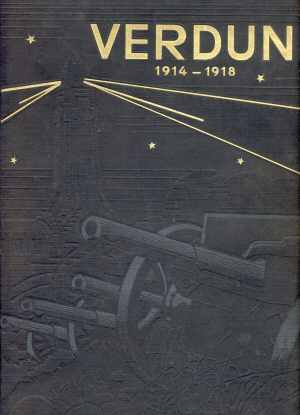 |
Let us start with the incredible 'VERDUN'by Péricard, published by Durassié in 1934. Adjudant with the 95th Infantry regiment during the conflict (and very critcized witness - author of the famous shouting 'Up Deadmen !', understood a little too much with the first degree by its detractors), Péricard completed here an ant work by calling on a multitude of French combatants having fought between 1914 and 1918 on this famous battle field (including the ‘Hauts de Meuse’). It is thus a chronology day per day, sometimes hour per hour, of the fights, stuffed with hundreds of witnesses of actors, reprensenting various arms and various ranks, enamelled with detailed trench maps and sometimes morbid old photographs. Essential reading for who wants to live again this period in this infamous place. |
Some appreciable help in the search for good works of witnesses can be found in the bibliographies of some serious and recognized works dedicated to the Great War. Before diving in my recommendations, here are for example some books which can guide your acquisitions :
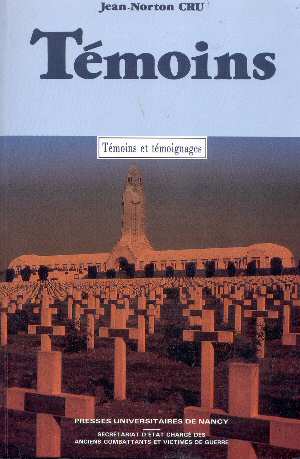 |
Windfall for the historian, this work gives a very exhaustive and meticulous report on the notebooks, memories, novels... published before its own selling in 1929. It started a huge polemic which is not yet completely extinct nowadays. Indeed, Jean Norton Cru, ex-serviceman and American citizen, defends in ' Témoins' a very straight thesis on witness. With this vision, if Genevoix, Delvert and Pézard or other Lintier (see below) easily pass this demanding test, all those which wanted to force the caricature to condemn the war as well as the talented writers with an artistic concern are classified 'bad witnesses' as well as the true inventors or the propagandists. The fact that you agree or not with this very dogmatic position (see also on my page "the great names of the literature") will not prevent you from consulting this work for its very rich bibliography. |
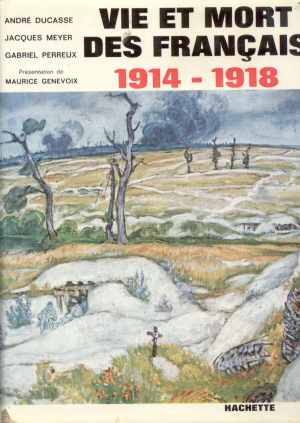 |
We will speak again of this REMARKABLE work written by 3 ‘normaliens’ ex-servicemen, (Ducasse - Meyer - Perreux) sponsored by Maurice Genevoix, in the section 'History Books'. Among the many merits of ' Life and Death of the French, 1914-1918 ' is a very rich and varied bibliography. This one is worthy of the general tone of the book, and opens with all the kinds, on the contrary rigid attitudes of Norton Cru. You can rather easily find this book in the secondhand booksellers, under one of its different editions. Warmly recommended ! |
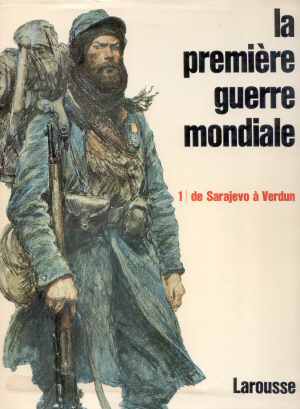 |
Another work (in 2 volumes) whose foreword is signed Maurice Genevoix - pledge of quality - and of which we will speak again in the section 'History Books' of this website. This ' Larousse Encyclopaedia of the First World War ', compiled by General J.E. Valluy is still easily found, and known to have choosen the good level of synthesis. The bibliography of this study is particularly complete, and well balanced between witnesses and historical or technical studies |
And now some authors, widely quoted in the biographies of the works above, whose reading will bring satisfaction to you, I hope... Preoccupated by the band-width, I only scanned one book cover per author, even when I have the other works in my library that I quote in the text.
Let us start with some French witnesses and novelists
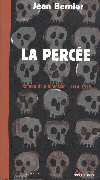 |
In this very autobiographical novel, Jean Bernier describes with accuracy (recommended by Norton Cru – this is to prove...) and great literary talent the anguishes of the french infantryman, unhappy and desperate on the frontline, misunderstood and revolted in permission. Descriptions of combat correspond to the vain and bloody offensives of 1915, terrible year during which the French high command sacrificed so many young lives in the search of this famous ‘Percée’ ("Break Through") - (1920)... The superb style, very modern, was little appreciated at the time, and this book passed almost unperceived. To read it, is to accept a mixture of hypnosis and cold fear, penetrated by straight to the heart sentences... Find some of these superb sentences in my section "quotations" |
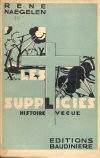 |
Remarkable work, if one forgive some romantic overflows of the author, Rene Naegelen, of the 172 R.I. Here better than in others, one takes the real rhythm of the ‘biffins’ (units of infantry), between the terror of the battlefields (what a talented pen to describe the chaos of Verdun, the battery of Damloup and the Tunnel of Tavannes) and compensatory leaves on the back of the front or in permission. In ‘Les Suppliciés’ ("The Torture Victims") - (1927), the life is made of an alternation of waitings and lengths, mortal risk under the invisible danger of the shells, and of unnamable and degrading carnage in the first line. |
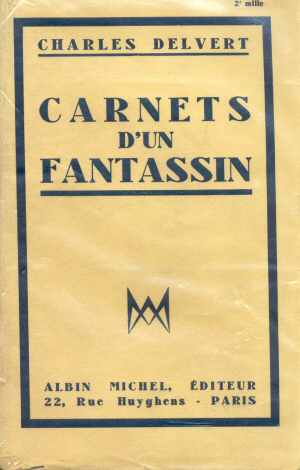 |
The captain Charles Delvert is a true hero; the combat in which he took part with its infantrymen in the neighbourhoods of the fort Vaux, in the middle of the battle of Verdun is one of those that forged the History. He tells this episode in his ‘Carnets d’un Fantassin’ ("Notebooks of an Infantryman") - (1916), as well as the life in the trenches of the ‘Main de Massiges’, in Champagne. But Charles Delvert is a modest hero and a very human officer, as well as a precise and objective observer. A very good book, therefore. |
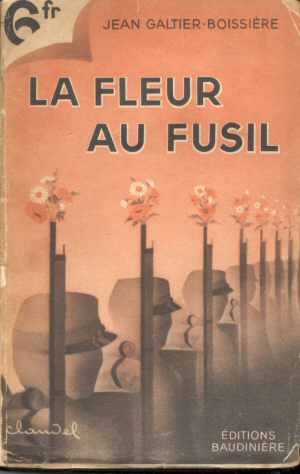 |
Jean Galtier Boissière was a prolific author : creator of the famous (and still alive) newspaper "Crapouillot" in 1915, tha was in the beginning a trench newspaper, he superbly wrote his memories of infantryman in war in several volumes. ‘Un Hiver à Souchez’ (« One Winter at Souchez") - (1917), ‘La Fleur au Fusil’ ("The Flower in the Gun") - (1928), and ‘Loin de la Riflette’ ("Far from Riflette") (1932). This writer also published a book entitled "The Great War", published in 1959 and reporting the conflict in a rather corrosive way, insisting strongly on the prosperity of the industrialists of the two sides... |
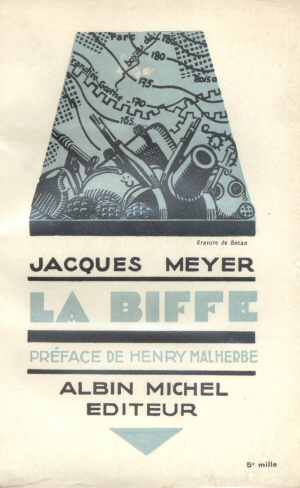 |
Jacques Meyer, joint author of the excellent work ‘Vie et Mort des Français 1914-1918’ ("Life and Death of the French 1914-1918") (see history books section of this site), is a student of the Ecole Normale, who became Infantry Lieutnant with the 329th Infantry Regiment. His war memories, collected in ‘La Biffe’ (« The Infantry ») - (1928) and ‘La Guerre, mon Vieux,…’ ("The War, My Old Friend...") - (1932), report with high humanism the miserable life of soldier he shared with his men, and the military actions he participated in. In a more modern study entitled ‘La Vie Quotidienne des Soldats de la Grande Guerre’ ("The Everyday life of the Soldiers of the Large War") - (1966), he takes more time to analyse the fortunes and misfortunes of the french ‘Poilus’. |
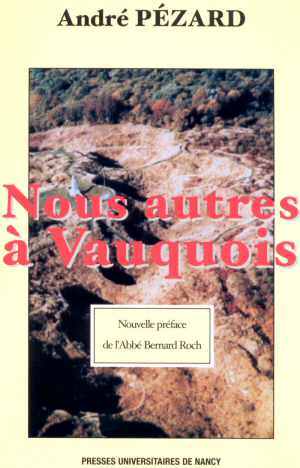 |
‘Nous autres à Vauquois’ ("Us in Vauquois") - (1918) is without discussion one of the best witnesses of this conflict. Lieutenant André Pézard knew the awful underground mine war that made of the village of Vauquois, in Argonne, a long scar of deep craters whose explosion splitted this hill in two and that you can visit today with a mixed emotions of fright and meditation. In this very nice book, he tells us what he saw with a high accuracy, and he makes us share so well his experience, that we sometimes quiver with him. . |
 |
One of the rare works reporting the memories of a soldier of the elite troops that which were the zouaves, recruited in european France in spite of their Exotic uniforms. Lieutenant of the macine-gun section, Louis Botti tells in ‘Avec les Zoauves’ ("With the Zouaves") - (1922) his war experience from the first days of August 1914 to September 1916, passing from Artois to Flanders and Verdun (and the infamous Hill 304), until the Somme where he was badly wounded then disabled. |
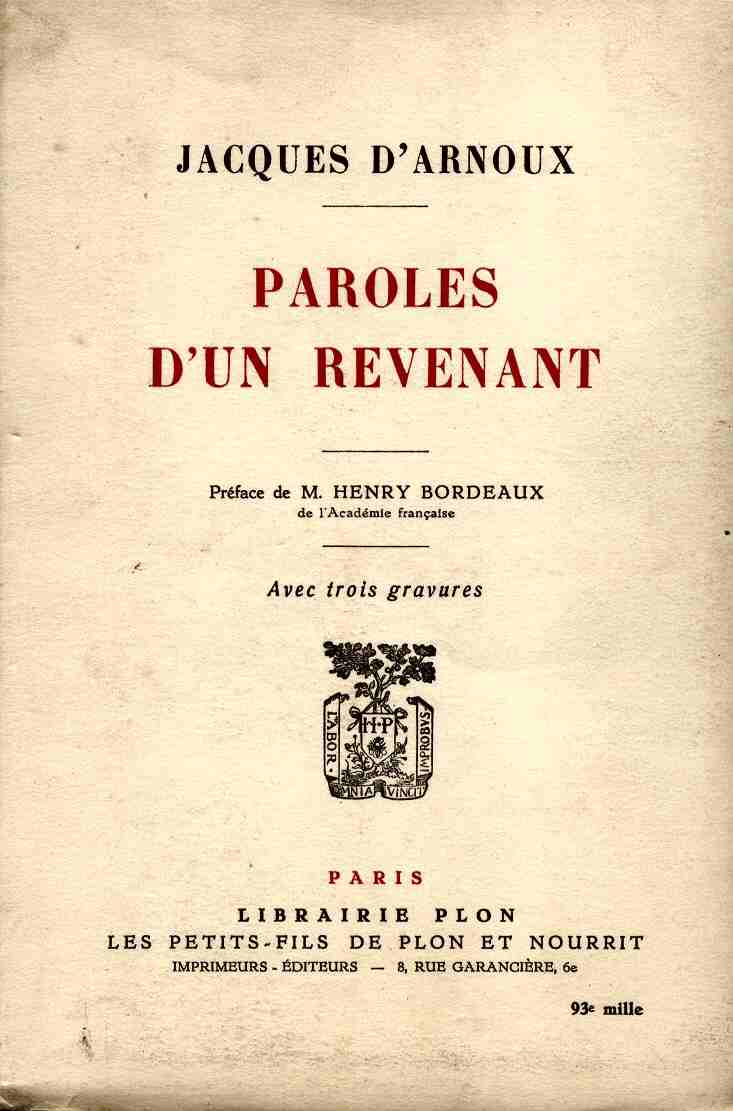 |
Officer in the infantry, Jacques d' Arnoux obtained his transfer to the Air Force. He was shot down in the no man's land of the Ladies’ Way, and, seriously wounded, brought back in the French lines by a zouaves patrol. The part of its book ‘Paroles d’un Revenant’ ("Words of a Ghost") - (1925) devoted to his slow and painful cure is impregnated of religious mysticism from which the author took his force of survival. |
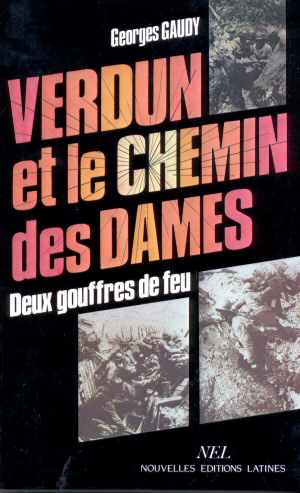 |
George Gaudy wrote several books, of which four are autobiographical : ‘Les Trous d’Obus de Verdun’ ("Shell Holes of Verdun "), ‘Le Chemin des Dames en Feu’ ("The Ladies’ Way on Fire"), ‘L’Agonie du Mont Renaud’ ("The Agony of the Renaud Mountain"), and ‘Le Drame du Saconin et l’Epopée sur l’Igon’ ("The Saconin Drama and the Epic on the Ingon"). These are very good witnesses, the parts describing the meeting of the relieving troops, distressed, with the downward units, dead tired and drawn, sounds true. A recent edition ‘Verdun et le Chemin des Dames : Deux Gouffres de Feu’ ("Verdun and the Ladies’ Way : Two Pits of Fire") gathers 2 of these volumes, but in a summarized version. I think it is not a good idea. A fourth work, 'Les Galons Noirs' ("The Black Stripes") is devoted to the regimentary priests. |
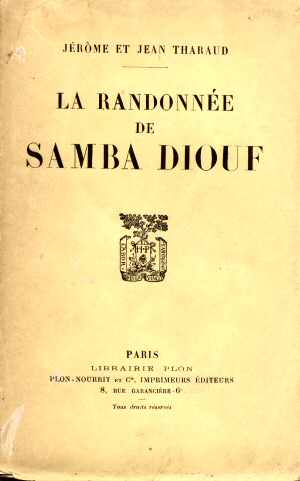 |
Samba Diouf is a young African leaving his village to join the city for an alleviating cause. Arrived at destination, he is enrolled in the French Army, transported to Europe, trained as a soldier and is engaged in the deadly fights. Quickly wounded, he joined back his village after this ‘Randonnée de Samba Diouf’ ("Excursion of Diouf Samba") - (1922). This history told by Jérome and Jean Tharaud, known authors before the war, adding to another war novel ‘Une Relève’ ("A Relief") - (1919), is that of many Senegalese riflemen who had to live this war with hallucinated eyes, as in a bad dream from which one can come back with a disabled member, or not come back at all... |
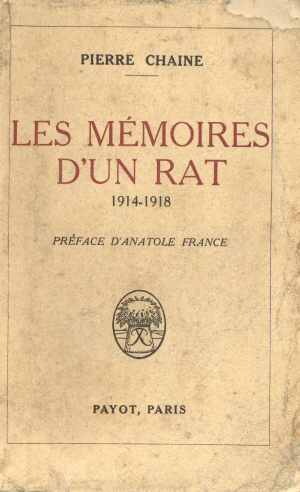 |
Ferdinand, trench rat by nature, sticks to his ‘Poilus’ fellows and writes after the war his reflexions. Wonderful little marvel of humour, but laughing with so much respect of the dramatic related history, this book ‘Les Mémoires d’un Rat’ ("The Memories of a Rat") - (1917), as well as its continuation ‘Les Commentaires de Ferdinand’ ("The Comments of Ferdinand") - (1918) is in fact an elegant disguise for the war memories of the author, Pierre Chaîne. |
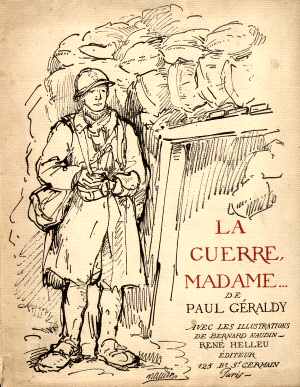 |
Lately republished, ‘La Guerre, Madame’ ("The War, Madam") - (1918) primarily concentrates on the incomprehension between the civil ones and the ‘Polus’ during their permissions in the cities. The beautiful writing places Paul Géraldy quite close to Jean Bernier (The Break Through), but with a slightly less significant storyboard. It does not matter : a particularly evocative extract enriches my quotation page. The edition that I have is illustrated very realistic pen-and-ink drawings. |
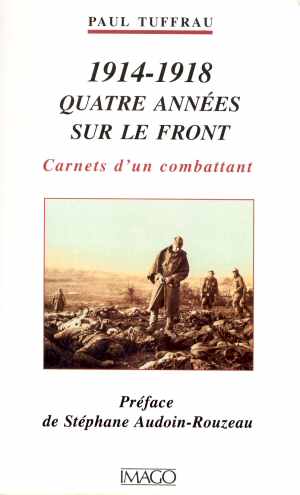 |
Officer with 246e R.I. from the very start of the conflict, Paul Tuffrau finishes the war at the position of head of battalion in the 208e R.I., and finally ' Kreisdirector' in SarreLouis in November 1918. He published his notes under the pseudonym "Lieutenant E.R." during the war in "Le Journal". Their realistic tone contrasted with the ambient heroism which reigned in the press at that time, which ensured its success as well with the combatants and the civils. These notes, completed with other texts until 1919, form the base of the Republished ‘Carnets d’un Combattant’ ("Notebooks of a Combatant") – (1919) |
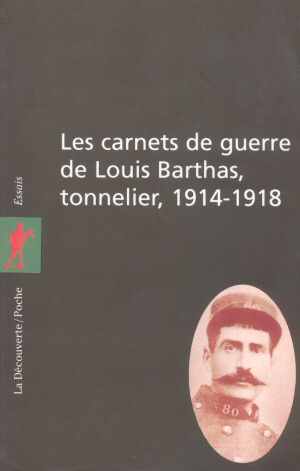 |
A few years ago, the ‘Carnets de Louis Barthas, Tonnelier, 1914-1918’ ("Notebooks of Louis Barthas, Cooper, 1914-1918") were said to be one of the preferred books of François Mitterand (former socialist french President). This peasant plunged into the war describes his adventures during this conflict in which he never killed anybody. Pacifist without being antimilitarist, Barthas shown much humanism. Through his eyes of mature man (35 years in 1914), farmer (originating in the Aude), he described with rare precision and emotion all the scenes he saw from 1914 to 1918. |
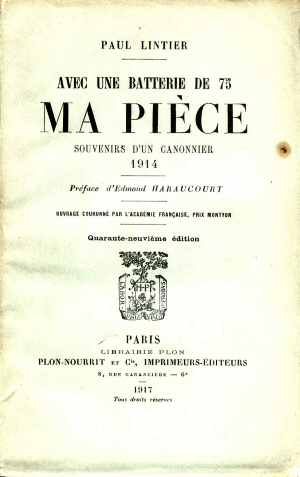 |
Paul Lintier stopped his law studies in 1913 to join the 4th Régiment of Artillery. It’s as a servant of a 75mm field gun that he knew the beginning of the conflict, taking part in the first combats (Ethe, Ourcq). After having taken part in the actions on Lingekopf and Hartmannwillerskopf, he saw the Champagne offensive of September 1915. Lintier is killed on March 15, 1916 in a quiet sector of Meurthe and Moselle. His notebook, published in two volumes, ‘Ma Pièce’ ("My Gun") - (1914) and ‘Le Tube 1233’ ("The Tube n°1233") - (1915-1916), was published during the war, a few months after its death. It’s a masterpiece of human feelings, and some will not hesitate to affirm, like Norton Cru who is one of his admirers : "if he had survived, he would have been one of most brilliant in the literary generation of the post-war period". |
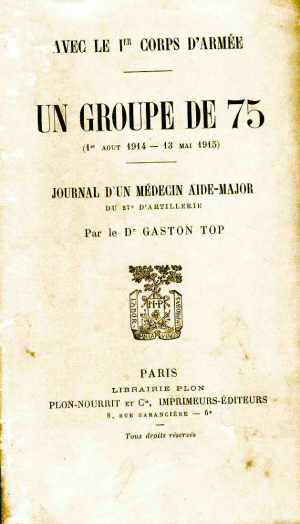 |
Doctor in a field artillery regiment (27e R.A.C.), Gaston Top was one of the very few representing his medicine profession to match the very severe criteria of 'good witness' of the very intransigent Norton Cru, at the sides of his Belgian fellow-member Max Deauville. His notebook, ‘Un Groupe de 75 – Journal d’un Médecin, Aide-Major au 27e RAC’ (« A Group of 75 - Notebook of a Doctor, Major of the 27 RAC") - (1919), covers the period from August 1, 1914 to May 1915. It is a sincere witness, unfortunately constrained to censor himself his September 1915 Champagne offensive notes, under the threatening pressure of his superiors. It is definitely less nicely written that the oeuvre of Duhamel, also engaged as doctor, but that surely sounds more authentic. |
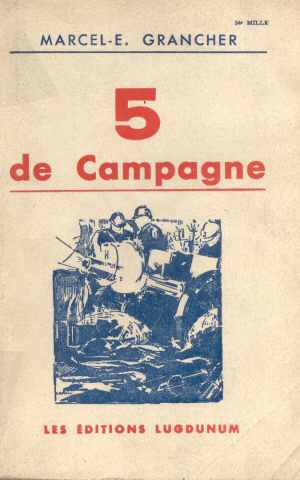 |
Let us continue with the artillery men. This one, M. Grancher, Military Medal seriously wounded, takes as a starting point his own war memories to write his ‘5 de Campagne’ ("5th of Field Artillery") - (1937), nearly twenty years after the conflict. Half of the book reports the instruction of an artillery man in the 5th Field Artillery Regiment, in Besançon at the beginning of 1916. The unit he then joined on the Belgian front is imaginary. The author wanted to use an ironic tone, and the 'troupier' comic side makes a great contrast with the other books of this bibliography. But the memories are precise, and invaluable witnessing. |
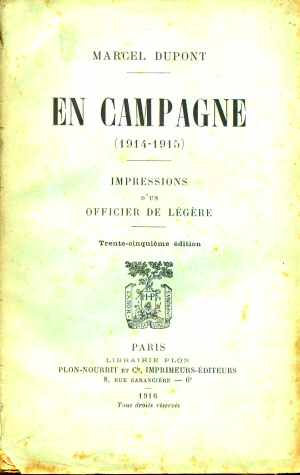 |
To publish his memories in the middle of the war, and to be employed as war correspondent with the newspaper ‘Le Correspondant’ ("The Correspondent"), Marcel Ernest Béchu, career officer with the 7th Cavalry Chasseurs used the pseudonym of Marcel Dupont. The first volume, 'En Campagne - Journal d'un Officier de Légère' ("In Campaign - Notebooks of a Light Infantry Officer") - (1915) covers the period of 1914 (Flandres), and the second 'L'Attente - Journal d'un Officier de Légère' ("The Wait - Notebooks of a Light Infantry Officer") - (1918), 1915 to 1917. It is in this second volume that is the most interesting chapter, desicated to the infamous battle of Verdun viewed from Divisional Headquarter. The remainder of the work oscillates between literature and witness, creating a great discomfort for Norton Cru. |
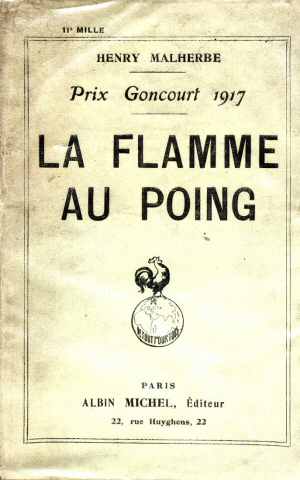 |
Rewarded by the Goncourt Price 1917 for its book ‘La Flamme au Poing’ ("The Flame in the Fist") - (1917), Henri Malherbe, Lieutenant with 4th R.A.C. wrote a work which is indeed quite interesting for its literary quality. This objective being clearly the first priority, the realism is not a preoccuppation, and we must admit that the work suffers of that consequence. The style sounds a bit aged, and certain sentences, sometimes heroic and sometimes macabre, seem a little dusty. But the lyricism (Malherbe will later write some musical critics) remains pleasant, and certain passages are really beautiful. |
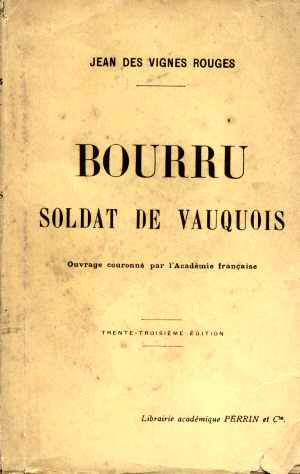 |
Career officer with the 231st and then 31st Infantry Regiment, 35 years old in 1914, and of weak health, Jean Taboureau only knew for 2 months the life of a fighting company. His various works, written under the pseudonym of Jean des Vignes Rouges, inherited from this poor front experience. ‘Bourru, Soldat de Vauquois’ ("Bourru, Soldier of Vauquois") - (1916), 'L'Âme des Chefs' ("The Soul of the Leaders") - (1917), ‘André Rieu, Officier de France’ ("Andre Rieu, Officer of France") - (1917) and 'Sous le Brassard d'Etat-Major' ("Under the HeadQuarters Arm-band") - (1919) are worth reading to understand why this kind of propaganda was scorned by the front men, who knew, them, that the war was not "fresh and pretty". The first volume should be read in parallel of the fantastic "Us in Vauquois" for contrast. |
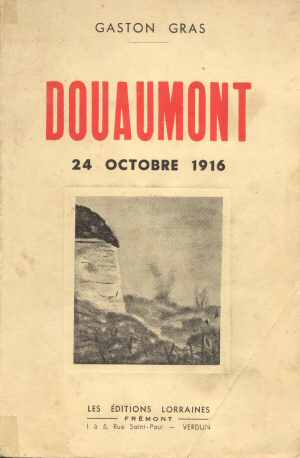 |
The sergeant Gaston Gras is enrolled in the heroic "RICM", the "Regiment of Colonial Infantry of Morocco", elite unit whose flag was the most decorated during the conflict. His first experience of fire was the conquer of the Fort of Douaumont by his regiment in October 1916. His book ‘Douaumont – 24 octobre 1916’ ("Douaumont - October 24, 1916") - (1929) is only dedicated to this famous action. Other works, rarer, permitted him to write other memories, of which ‘Malmaison – 23 octobre 1917’ ("Malmaison - October 23, 1917"), reporting the engagement of this same unit in the offensive of the same name on the Ladies’ Way, led by Marshal Pétain to reinflate the morale of the troops after the April offensive fiasco. |
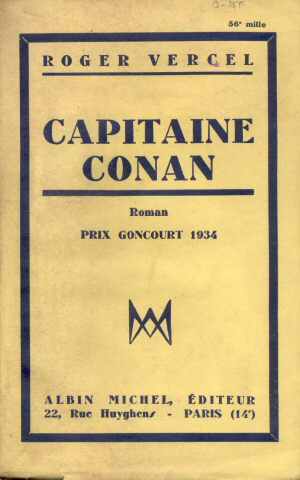 |
Adapted to the cinema some years ago by Bertrand Tavernier, ‘Capitaine Conan’ ("Captain Conan") by Roger Vercel offered a pretext to a lesson on the violence of the war, and the transformation of the men into wild beasts. This theme was explored a half century later on several occasions about Vietnam War. The second characteristic of this book lies in the operations terrain which is used, since we follow the adventures of this officer of French Forces on the front of the Carpathes. |
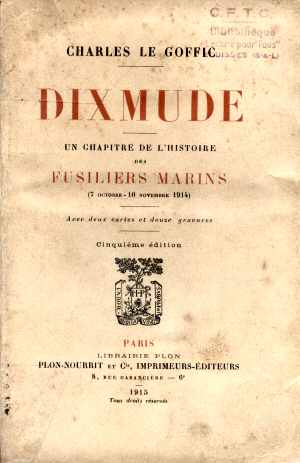 |
Charles Le Goffic is not a direct witness. On the other hand, his son was a doctor with the 1st regiment of the Brigade of the Marine Fusiliers. In "Dixmude" (1915), the author tells the keen and quasi desperate combat of that unit, at the sides of the remainders of the Belgian army, at the doors of this city of Flandres. Written in the middle of the conflict, by a non-combatant author, we must not be astonished by the heroic tone, too often at the detrimental of the credibility. It is however a precise book of history, for who wants to understand this crucial action of 1914. |
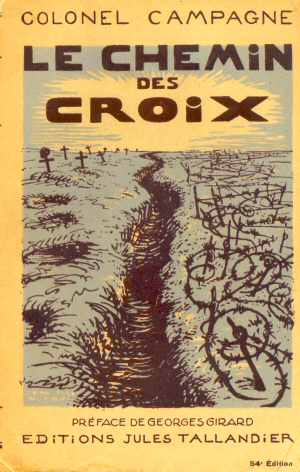 |
Head of battalion in the 107e Infantry Regiment, colonel Campagne lived with his men the combat of the Marne, Champagne, Lorraine, Artois, Verdun and the Somme, before receiving in 1916 the command of the 78e Infantry Regiment that it keep until the end of the war on the italian front. He tells this epic in ‘Le Chemin des Croix’ ("The Road of the Crosses") - (1930). His witness is exceptional since only a few other unit leaders wrote their war memories, but none of them did it whith such a nice speak and with so many respect of its men, who returned their affection to him. |
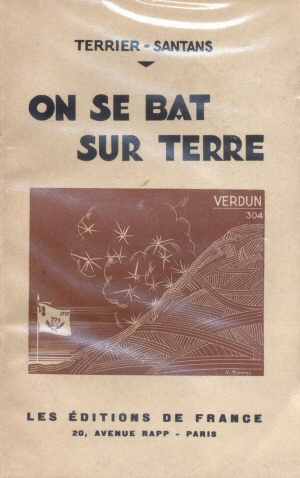 |
Fighting with the 77e Infantry Regiment, the author, Terrier – Santans, described the terrible experience of the keen combats on Hill 304 in May 1916, on the front of Verdun. In spite of the title ‘On se Bat sur Terre’ ("Men Fight on the Earth") - (1930), which could suppose the existence of a certain compassion, this witness mainly valuable for the quality of the descriptions of the military actions and the terrain. It could be a regimental historical official notebook. The psychology of the soldiers is minimal, and their stoicism rather suspect. I do not know the rank of the author, but his book 'smells' the experience of a regiment or battalion headquarter officer. |
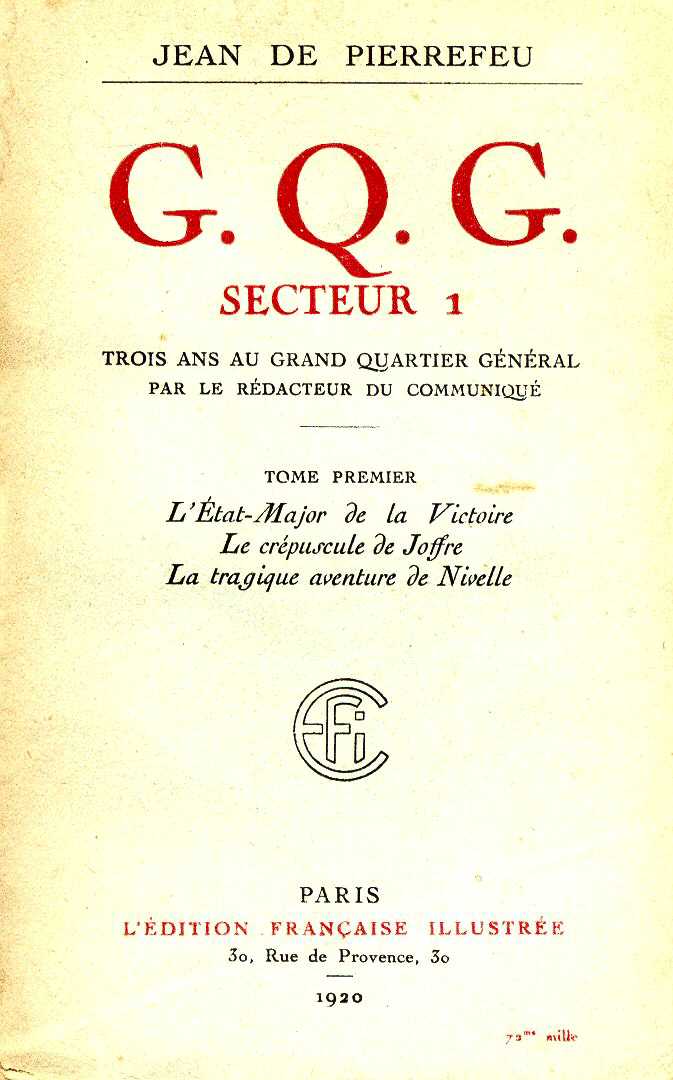 |
Infantry officer, wounded in 1915, Jean de Pierrefeu was affected to the General Headquarters until the end of the conflict. He will be the writer of famous 'Daily Official Communiqué'. His memories in two volumes ‘G.Q.G. Secteur 1 – Trois Ans avec le Grand Quartier Général par l’Auteur du Communiqué’ ("G.Q.G. Sector 1 - Three Years with the General Headquarters by the Writer of the Official Communiqué") - (1920) are very interesting, because the author was in direct contact with the most powerful french leaders of these times, during the crisis moments. The delicate problem of the everyday building of the Official Communiqué is also extremely interesting. He also published a significant work of reflexion on the war: ‘Plutarque a Menti’ ("Plutarque Lied") (1923). |
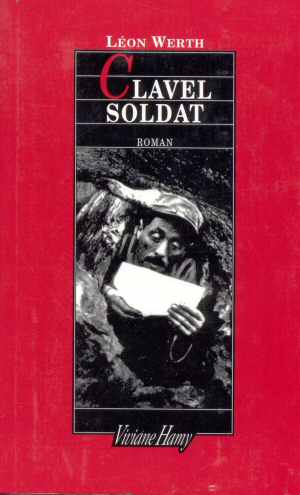
| When Paul Werth, 36 years, antimilitarist and admirer of Jaures (french socialist leader before the war, assassinated in august 1914) is confronted with the general flashover of 1914, he cannot be prevent himself from leaving to the front as a volunteer, to defend his ideal of the liberty. This feeling will quickly be submerged by a wave of dislike, and contempt for the world that surrounds him and his comrades of misfortune. His novel 'Clavel Soldat' ("Private Clavel") - (1919) is rigorously autobiographical, and describes with fidelity this bitter experiment. It is a dark book, aggressive, pessimistic, but it is a great book. |
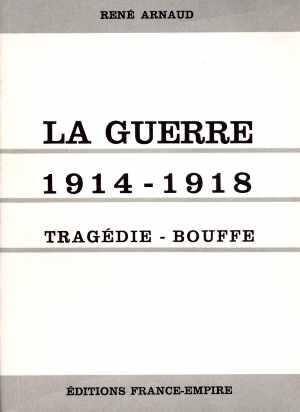 |
The year 1964 saw the appearance of many books celebrating the 50th anniversary of the beginning of the conflict. ‘La Guerre 1914-1918, Tragédie-Bouffe’ ("The War 1914-1918, Bouffe Tragedy") was thus written by the former captain of infantry Rene Arnaud who took the occasion of the retreat of the passed years to tell his memories under a sometimes serious tone, but often ironic. This can disturb the purists, but it is at least original. Note that one third of the book is made of a long appendix summarizing the history of the conflict. |
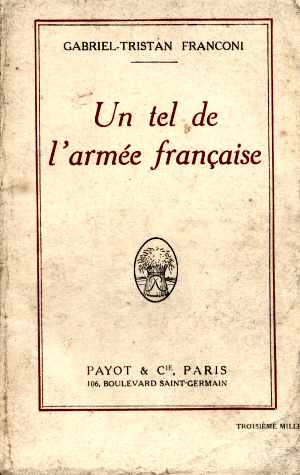 |
Gabriel-Tristan Franconi began the war in artillery, before requiring in 1915 his move to the infantry. Badly wounded in 1916, he joined his regiment in August 1917, and was a second lieutenant when he was killed on July 23, 1918. His novel ‘Untel, de l’Armée Française’ ("Someone from the French Army") - (1918) rather accurately recalls his history, naming himself ‘Someone’. But if the style is harmonious and well polished, the epic and heroic tone gives a good idea of the real feelings expressed per so many 'Poilus'. This is what makes the originality of this work. |
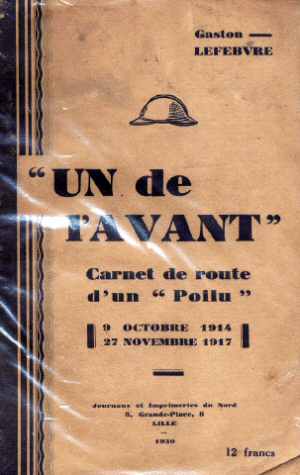 |
Young teenager living in Lille, Gaston Lefebvre left his family and ran away to avoid the German invasion of October 1914, joining the French Army. At the end of a 4 months instruction, he is Incorporated in the 7th Infantry Regiment in May 1915. In its memories written after war, ‘Un de l’Avant’ ("One Guy from the Front"), he reports this experience, as well as the furious and bloody fights to which he took part : The Aisne, Berry-au-Bac, Verdun, the Somme, and the Champagne from where he was evacuated with a serious wound that will cost him the amputation of a leg... If the desires of heroism of the beginning are quickly swept by the lived horror, the mutilated young person wrote 10 years after the witness of a young soldier full with ardour, and that sounds true. |
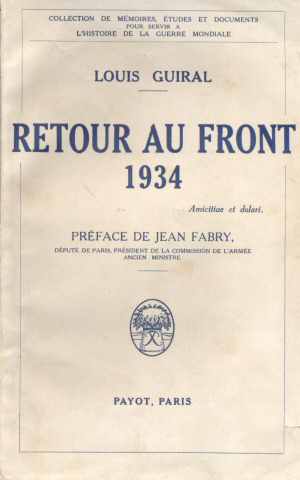 |
We will speak again of Louis Guiral in the pages on the History Books, with its ‘Je les Grignote’ ("I Nibble Them") which recalls the Champagne offensive of September 1915. But ‘Retour au Front 1913’ ("Return to the Front 1934") reports his pilgrim impressions, on the steps of its martyrdom 19 years after the battle. With an alternation of observations of the state of the front of Champagne in the Thirties and flashbacks, Guiral manages to make us understand the emotions felt by the ex-servicemen returning on the places of their wartime miserable life. Simple and moving. |
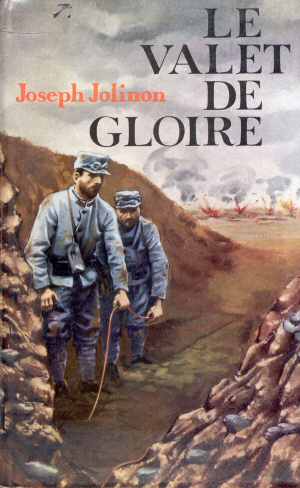 |
War novel written to expose a thesis, ‘Le Valet de Gloire’ ("The Servant of Glory") - (1923) allows his author Joseph Jolinon, a 28 year old lawyer enrolled in the infantry in 1914, to draw the scene of the most dramatic episode of his war. He was effectively called in May 1917, in the middle of the mutinies crisis in the French Army after the failure of the Ladies’ Way offensive, to be a defender at the Court-Martial. Deeply shocked by this experience, he builded all his story around this injustice, and it is thus a particularly hard indictment which lies under this novel. |
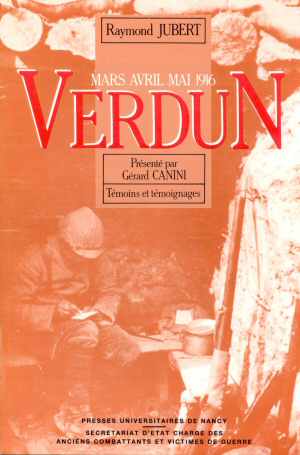 |
Three months of fights at Verdun from March to May 1916 at the ‘Homme-Mort’, this is what is told by the candidate officer Raymond Jubert in his memories simply entitled "Verdun" (1918). The visceral wish of this young man, who was to die in the combat at 28 years old in 1917 close to Douaumont, was to preserve intact his memories and impressions of war, without letting them deform by the stuffing of the journalists and warmonger authors. These pages are moving, the suffering is real. A really beautiful book ! |
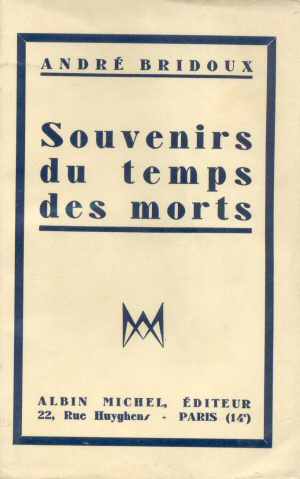 |
Here is quite a strange book. The young zouave Andre Bridoux, became officer with the 2nd Regiment of Zouaves in September 1916. Young scholarman, he said that he never found in the other war books a faithful description of his own experiences. His ‘Souvenirs du Temps des Morts’ ("Memories of the Time of Dead") - (1930) thus sticks more to retranscribe his feelings, "to undertake his examination of conscience". It is not a question of memories chronologically ordered, but rather of beautiful reflexions on various topics. Very interesting book which helps our comprehension of the Poilus suffering. |
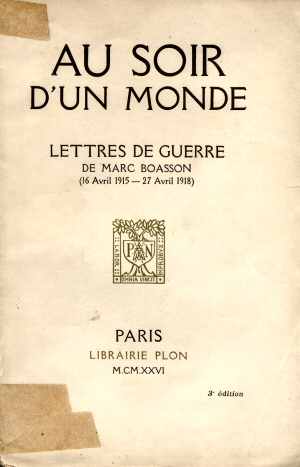 |
Enthusiastic catholic, Marc Boasson, art lover scholar, made the war in the infantry, from April 1915 until his death close to the Kemmel Hill in April 1918. During all this time, he wrote long letters to his wife, elegantly using the french language to tell her of this terrible experience, without frightening her. Extracts of these letters were brought together by his wife in ‘Au Soir d’un Monde’ ("At the Evening of a World") - (1926). It is necessary to go beyond the simple pleasure of reading this beautiful text enamelled with culture and memories of pre-war period, to unearth the 'shout of anguish to stop the doom' that discovered Norton Cru in his analysis. |
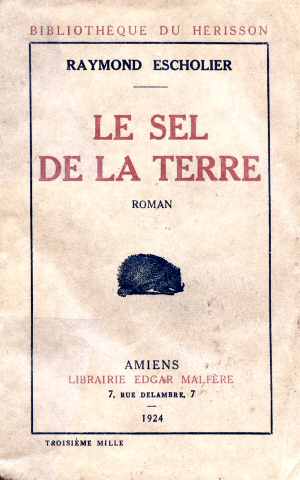 |
‘Le Sel de la Terre’ ("the Salt of the Earth") - (1924) is a war novel. But the parallel between the author, Raymond Escholier, and the hero (Bussières) is so perfect (59e Infantry Regiment, military cursus leading from the headquarters to the trenches, visited sectors including the infamous 304 Hill close to Verdun in April 1916) that it is obvious that this book is in fact his war memories. The style can sometimes seem a little too worked, but it is anyway a great witness, extremely moving. The moral tearing of a comrade sergeant, monk in the civil life and frightening warrior in the action, or the incredible scene of the bombing by minenwerfer are unforgettable... |
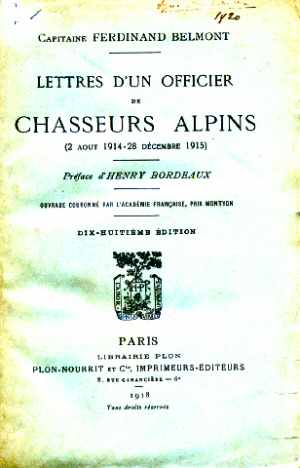 |
Second lieutenant in the reserve, mobilized with the 11th Battalion of Alpine Infantry since of August 3, 1914, Doctor Ferdinand Belmont saw in this elite corps the first combat of the Vosges, then the Somme, Flanders and Artois. On his return in the Vosges at the beginning of 1915, promoted Lieutenant then Captain, he will fight at Metzeral, then on the Lingekopf, and finally on the Hartmannswillerkopf where he will be mortally wounded on December 28, 1915. The ‘Lettres d’un Officier de Chasseurs Alpins’ ("Letters of an Officer of Alpine Hunters") - (1916) show the remarkable correspondence that he sent to his family until the day of his death. |
 |
Humanist and cultivated, educated in a Clerical school of the Diocese of Autun, Paul Cazin is already 35 years old when the war bursts. He joined the 29e Infantry Regiment and takes part with that unit from March 1915 to July 1915 in the combats of Lorraine and of St Mihiel, before being evacuated for illness. Called "Grandfather" by his young soldiers, this sergeant wrote many inflamed letters to his wife, in whom he tells very accurately his acts and thoughts, in a nice style peppered with Latin or Greek quotations. His ‘L’Humaniste à la Guerre’ ("Humanist at War") mixes these letters with extracts of his war notebook. |
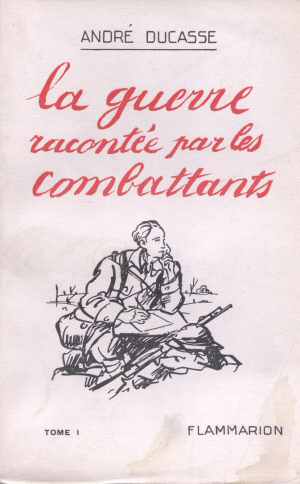 |
Joint author of my favourite ‘Vie et Mort des Français’ ("Life and Death of the French"), André Ducasse, who lived the Great War, gathered in the two volumes of ‘La Guerre Racontée par les Combattants’ ("The War Told by the Combatants") - (1932) some extracts of classical or less known works written by witnesses of the conflict, in an attempt at "Anthology of the Writers of the Front". They are more than one hundred of writers who are thus quoted, and their texts gathered in homogeneous themes. |
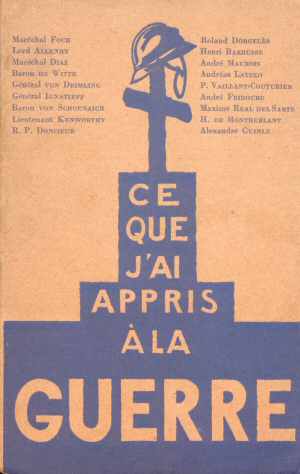 |
Among the works devoted to fighters witnesses, this one presents a very original characteristic: 'Ce que j'ai Appris à la Guerre' ("What I Learned at War") - (1927) gathers the answers to a question to various actors of all camps and all ranks, synthetically asking them what the war had transformed inside of them. Original texts of Foch, Allenby, Dorgelès, Barbusse, Maurois, Latzko, von Schoenaich, de Montherlant... |
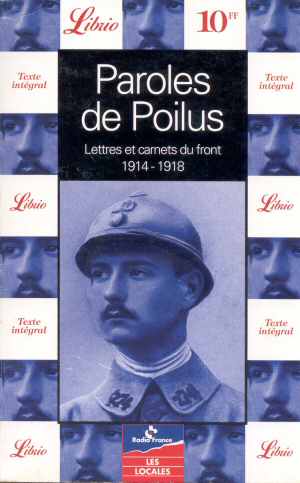 |
Eight thousand french people answered the call of Radio France, asking to collect the letters, scattered up to now, of the eight million ‘polus’ mobilized between 1914 and 1918. A few tens of these letters were selected, and read on antenna. ‘Paroles de Poilus’ ("Words of Polus") - (1998) is made with these really moving letters, touching us with their simplicity and their humanity. There is also a well-known CD, sold separately, that makes it possible to listen to the same texts read by young men of the same age than the writers. |
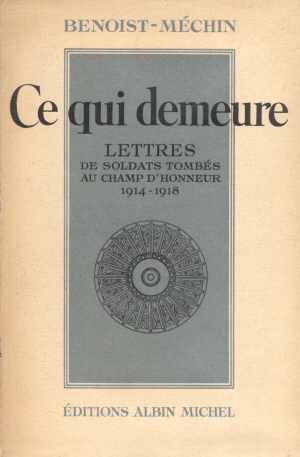 |
‘Ce qui Demeure – Lettres de Soldats Tombés au Champ d’Honneur 1914-1918’ ("What Remains - Letters of Soldiers Fallen at the Fields of Glory 1914-1918") – (1942) joins under the pen of Mr Benoist-Méchin (who will write also a famous ‘Histoire de l’Armée Allemande’ – ("History of the German Army"), the last letters of 40 soldiers killed at war. Among less celeb ones, one will find writings of Charles Péguy, Alain Fournier, Marc Boasson, or Ferdinand Belmont. Published under the german occupation in 1942. |
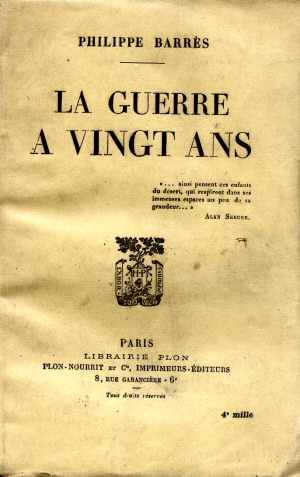 |
Auguste Barrès, officer in the Napoleonic armies, had his memories published by his grandson Maurice Barrès. If this one went famous for writings or publications in the theme of the heroism and nationalism, his son, Philippe Barrès, infantry officer, signed with his autobiographical novel ‘La Guerre à Vingt Ans’ ("The War at Twenty Years Old") - (1924), a very human book, sober and straight, bringing inter alia a witness of the mutinies of 1917. I supposed that kind of detail was not fully appreciated by his father ... |
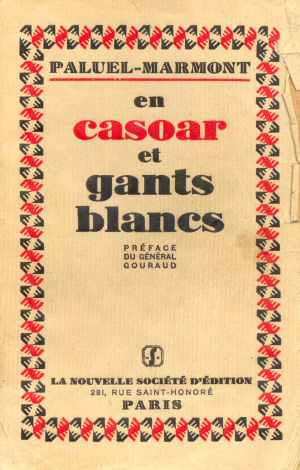 |
Paluel-Marmont is one of these young pupils of the famous military academy of Saint-Cyr school, well-trained, who so often showed high levels of heroism during the conflict. Alas, the heroism of 1914 has also for the French Army the taste for 'panache', and the oath taken by these young officers to lead their troops to the combat ‘En Casoars et Gants Blancs’ ("In Casoar and White Gloves") (the Casoar was their hat decorated with white long feathers, typical to that elite military school), so easily locatable by the German mausers, brought them to a terrible hecatomb. Useless ? Exempalry ? Each one (whose General Gouraud, author of an enthusiast foreword) will forge his own with this book. |
 |
Young 22 years old medical student, Lucien Laby was enrolled as a candidate, auxiliary doctor, within the 56e division of reserve infantry. After the first fights of 1914 he was designated as a batallion doctor in the 294th Infantry Regiment R.I., and saw in the first aid stations of the first lines of the Champagne front in 1915, Verdun then the Somme in 1916, and the Aisne in 1917. He finished the war in a safer place in Belfort, then in Alsace. His ‘Cahiers de l’Aspirant Laby’ ("Notebooks of the Candidate Laby"), only published in 2001, and illustrated with nice drawings made by the author, are thus an exceptional log book, not only by the length of the covered period, but also thanks to the quality of the witness. |
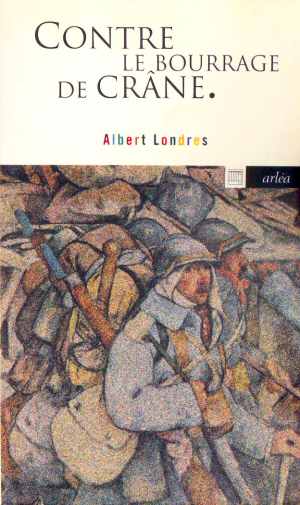 |
Who knows that one of greatest press reporters of the century, Albert London, wrote many reports from the front, fighting against the censure (the famous scissors nicknamed "Anastasia") that he hated so much ? In this collection ‘Contre le Bourrage de Crâne’ ("Against the Stuffing"), tens of articles covering the period from July 1917 to December 1918 and published in "Le Petit Parisien" are made available for us. The author often succeeds, with a very professional ink, to describe the life of the front while remaining on the edge of the censors scissors, sailing between military apology and sourness... |
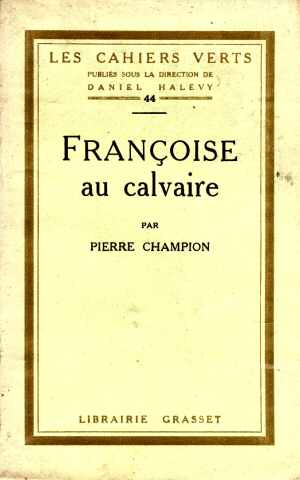 |
With Pierre Champion, infantry officer since May 1915, it is the distress of a provincial wife whose husband – the author’s ordinance - is killed, that gives the theme. This history is tactfully and humanly told in ‘Françoise au Calvaire’ ("Francoise on the Martyrdom" (1924). This author was one of rares to declare how much the peasants had paid the heaviest tribute to this hecatomb, and to recommend the the reading of the letters and correspondences of soldier to approach the live truth of the war. |
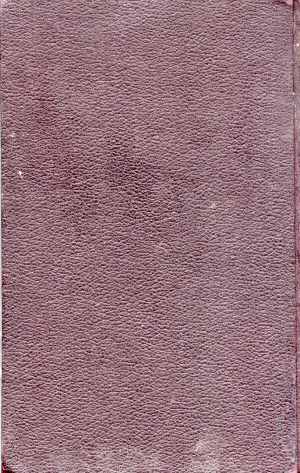 |
In ‘La Comédie de Charleroi’ ("The Comedy of Charleroi") - (1934), Pierre Drieu La Rochelle tells the journey of a former soldier returning after war in Charleroi (Belgium) on the spots where he fought and where his comrade was killed. The mother of this latter, in search for an heroic image to relieve her pain, accompanies him in this pilgrimage. Pious lies, memories of defeat, panic and confusion, we are far from the heroes of the official History... It was necessary to be courageous to write a novel based on one of the most humiliating french defeats of 1914, even in 1934 ! |
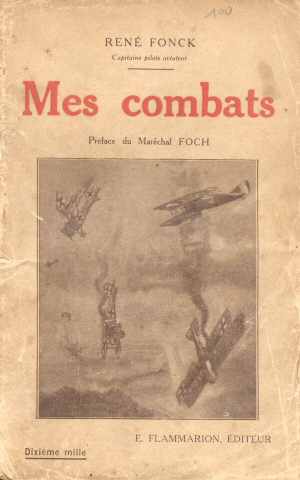 |
Realizing how much this review is mainly filled with war experiences of land forces witnesses, I want to notice quickly some memories or biographies of the flying heroes. Their reading is often a little disappointing compared to book of 'the ground staff', because even if nobody disputes the brutality of the aerial combats and the terrible rate of losses, these 'Aces' were so much deified by the press during the conflict that their history is too often told like a legend. Among the books that we can find : ‘Mes Combats’ ("My Combats") by Rene Fonck (1920), ‘La Vie Héroïque de Guynemer’ ("The Heroic Life of Guynemer") by Henry Bordeaux (1918) or ‘Navarre, Sentinelle de Verdun) ("Navarre, Sentinel of Verdun") by Jacques Mortane (1930). |
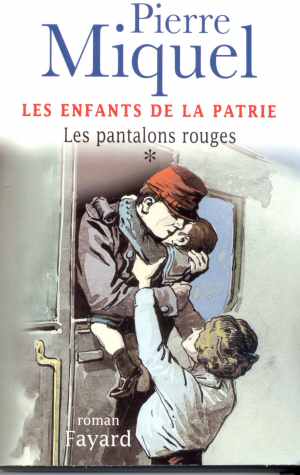 |
I quote this work in 4 volumes because you will find it without difficulties in the french bookshops. But if Pierre Miquel is a famous historian of the Great War (see the section "History Books"), strongly mediatized and rather wrongfully criticized by quite a lot of much of this period enthusiasts, he is not a talented novelist. It’s a shame, since the idea was quite good, following the destiny of these brothers embarked in the conflict in different arms through 4 volumes named ‘Les Enfants de la Patrie’ ("The Children of the Fatherland") - (2001-2002). Unfortunately, we do not believe in that story, nearly comparable to one of the extraordinary adventures of Sir James Bond... |
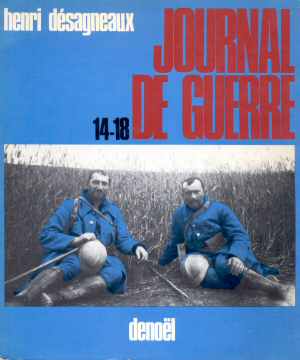 |
Appeared only in 1971, after the death of its author, the ‘Carnets de Guerre 14-18’ ("War Notebooks 14-18") of Henri Désagneaux contain the notes of this mature man, enrolled in 1914 in logistics (railroads), then integrated at the beginning of 1916 in the infantry as an officer with the 359 Infantry Regiment. He will experience with his company the Lorraine, the hell of Verdun from May to July 1916, the Somme, the Vosges and the Aisne. The originality of this edition remauins in the parallel made between the simple and direct notebook writings and the texts extracted from the contemporary press reporting the same history. One easily understands how strong was the feeling of treason for the ‘Poilus’, reading these newspapers... |
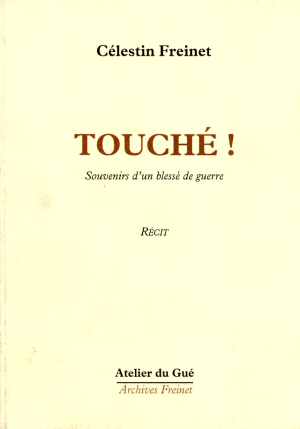 |
This superb little book is dedicated to the pain of a young 21 years old French lieutnant, hit ( "Touché") by a bullet in the left lung near the 'Bois des Gobineaux', on the Ladies' Way, early in the first pages of the story. Célestin Freinet, telling here his own personnal experience as a tragic and painful dream, will later become a famous pedagog. You have to read those few pages because they will move your heart like no others, and bring your soul to an intense compassion for this child who is oscillating between life and death in the fog of his suffering. |
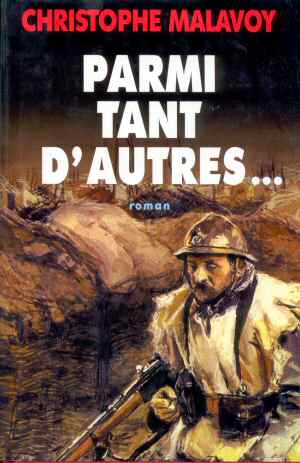 |
French actor of the present time, Christophe Malavoy, searched in his family's memories and crops the few souvenirs let by his grand-daddy, Lieutnant in the 96 I.R. and killed in action in Champagne in march 1915. In his book "Parmi Tant d'Autres" (Amongst so Much Other Men), he is reviving with an immense compassion, colored by familial love, the long agony of André Malavoy, who is leaving a pregnant wife at home. Simply beautiful... |
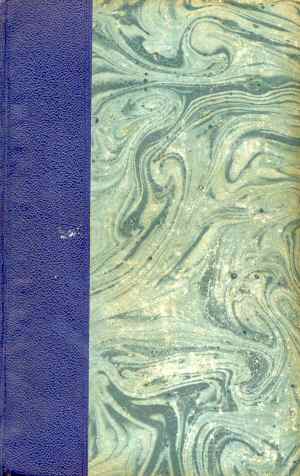 |
The Commandant Raynal received, in may-june 1916, the important mission to lead the Vaux Fort defense, on Verdun battlefield, against furious assaults of the German troops. The resistance he organized, in the dark, the thirst, the smell and the terror of underground fightings was so impreesive that it induced a deep respect in both sides of the frontline. He is telling himself this story in "Le Drame du Fort de Vaux" ("The Vaux Fort Drama"), with a certain military emphasis. But who could stay entirely modest after such an heroic fight ? |
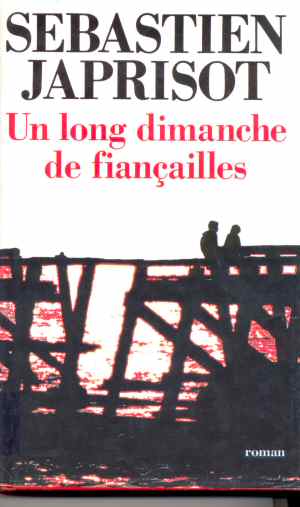 |
Many people saw the french film "Un long dimanche de fiançailles" ('A Long Engagement Sunday'), in which the French actress Audrey Tatou is Mathilde, a young girl questionning herself about her boyfriend fate, who disappeared on the Somme battlefields in 1917, and is searching for him alive against all evidences. A good exercise of wwI mood reconstitution for some, 'Amélie Poulain in the Trenches' for the others, anyway, the book that inspired the scenario, written by Sébastien Japrisot is remarkable. Behind the nice novel is an evocation of the polemic concerning the punition given to the French self-mutilated soldiers. |
 |
AbbotThellier de Poncheville was 39 when, in august 1914, he was enrolled as army chaplain in the 28th division. His war experience dramatic apogee happened in Verdun, where he made his job, mostly in the frontlines, from the february 26th 1916 to the january 1Oth 1917. Therefore his book, "Dix Mois à Verdun" ('Ten Months in Verdun') is an exceptionnal witness of the full length of this terrible famous battle. This man has been close enough to the French fighters and shared their miserable life, their suffering, and has been so often by their side at their trepassing time that he is well placed to express a sincere and pure compassion for them on each page. A lot of patriotic talking too, sometimes surprising, but quite often found in the enrolled French priests of WW1. |
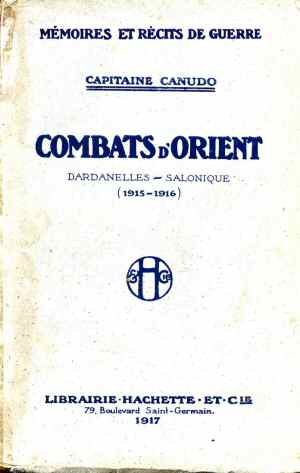 |
Italian citizen coming from the 'Pouilles' region, and engaged as a volunteer in 1914 at 35 y.o. as an officer in the famous Garibaldi Legion (officially named the '4th wartime regiment of the French Foreign Legion), Ricciotto Canudo took part to the terrible 20 fighting days of the Garibaldi Boys in the Argonne forest. Later, when Rome declared war to Berlin, he asked not to join the mobilizing Italian Army and joined the French 1st wartime regiment of African Troops (the famous 'Zouaves'), going to Gallipoli expedition, then, Serbia and Macedoine. Thçs brave soldier stayed in the south-east front until the end of the war. His book, "Combats d'Orient" ("Eastern fights" - 1917), tells the story of the whole year 1915, from Gallipoli to winter 1915 retreat from Serbia (whose description is worth reading). A second book, "Mon Âme Pourpre" ("My Purple Soul") tells the souvenirs of the Argonne fightings in 1914, and the Vardar battles in 1917. |
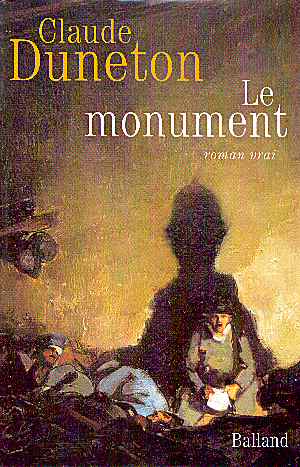 |
Claude Duneton is a French contemporary writer, knowned for several hististoy or philosophic books. Born in Corrèze, in the very deep of center France, he was impressed as a child by his father's revolt, a Verdun survivor, during the official ceremonies in front of the small Lagleygeolle village's death's monument. This souvenir, together with the one of the eternal mourning of the old ladies, that incited him to write the wartime story of this small village in his book "Le Monument" ("The Monument"), and let the 27 young men whose names are written forever in the stone live again, even if their sacrifice seems forgotten yet. |
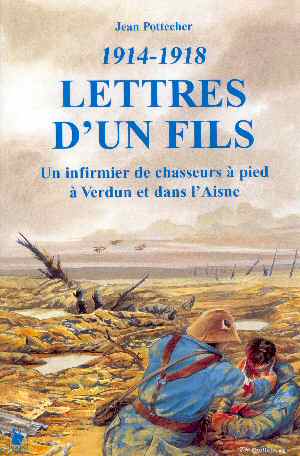 |
Being 19 in 1915, from a bourgeoisie family (his father, Maurice Pottecher, was a relatively well knowned dramatic author), student from the 'Ecole Normale', and enroll as a volunteer stretcher-bearer. To live 24 months of hell in Verdun, risking his life to crawl in the no man's land trying to save the wounded soldiers, refusing the promotions to higher ranks. To die on a nice day of July, 1918, while doing that noble mission once more, this is the fate of Jean Pottecher. Until the very last day, he wrote letters to his family, telling this experience. These words (unhopefully slightly corrected for the style by his father, afterwards) are collected in this book, "Lettres d'un Fils" ("Letters of a Son"). Very nice. If heaven exists ... this guy must be there. |
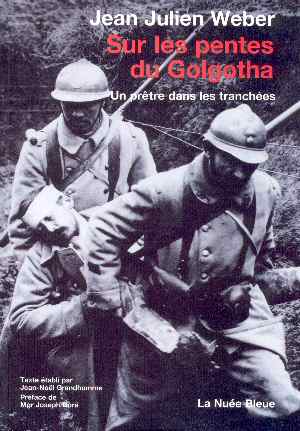 |
Well before becoming in 1945 the bishop of Strasbourg, then archbishop, Jean-Julien Weber was a young priest-soldier, officer in the 21st Infantry Regiment, son of a carreer officer. He fought with this regiment in Alsace, Vosges, Marne, Artois, Champagne, the Somme and Marne again. Wounded several times, he ended the war with the rank of Capitaine. His memories, "Sur les Pentes du Golgotha" ("On the Slopes of the Golgotha"), whose title seems to be inspired by his experience on the bloody Notre Dame de Lorette hill, let the human part of the man appear, composing the military sense of duty, nationalism, christianism, humanity and cleverness. This book is very intersting for both the historical value of this witness, as well as its philosophy. |
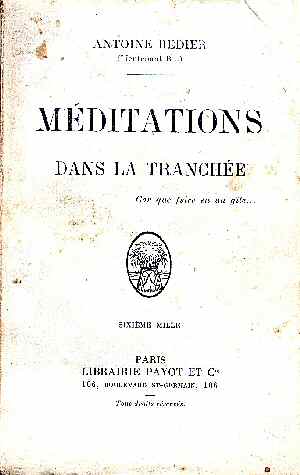 |
Sergeant, the officer in the 338th Infantry Regiment, Antoine Redier, young lawyer, was engaged on the Avre river region, before joining the headquarter in 1916. This experience in a fighting unit gave him inspiration for some deep reflexions on specific thematics, from the duty to the fatherland, including the ennemy, the glory, the honor, the brothers in arms, etc... These lines are compiled in "Méditations dans la Tranchée" ("Meditations in the Trench"), edited in February 1916, and saluted by the intellectual France as the first 'fighting philosopher' book of the conflict. It is therefore preferable not to hope finding in these chapters fight stories, but this reading is interesting 'in the second positions', to enrich the comprhension of more direct and 'first lines' readings. |
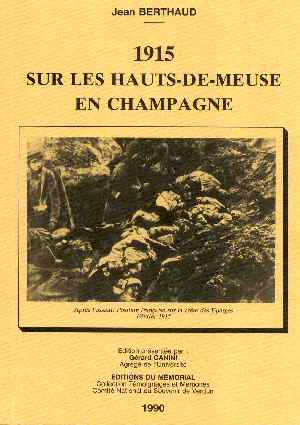 |
Jean Berthaud, from the class 1914, is a sergeant in the 147th Infantry Regiment when, in june 1915, he is sent to war for the first time in the Eparges, terrible place knowned for its muddy horror and the mining war, under Verdun, before participating in the September 1915 offensive in Champagne on the Tahure hill ('Butte de Tahure'). His war continued for long years afterwards, but his memories, "1915 sur les Hauts de Meuse, en Champagne" ("1915 on the Meuse Highs, in Champagne"), stop in the end of 1915, with the painful naming of all his best friends, disappeared and diluted in the battlefield mud. ("The Eparges cemetary... it's the whole hill !). Jean Norton Cru would have appreciate this witness, all in suffering. |
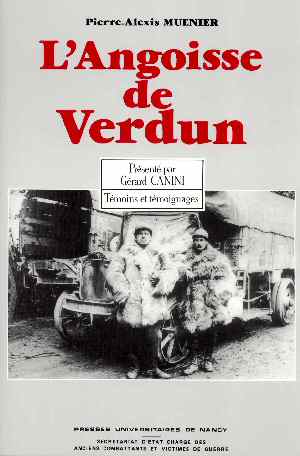 |
Quite a unusual witness, though very important : "L'Angoisse de Verdun" (The Anguish of Verdun") is an extract of the war notes of Pierre-Alexis Muenier, who was motorised truck pilot, in charge with the transportation of the wounded soldiers from the first line dressing-stations to the rear hospitals. His story is situated at the very first hours of the German offensive on Verdun, in February 1916, where his unit is scrambled. Hallucinating shoked wounded soldiers, confuse and unclear military situation, bumpy roads and dying vehicles torturing their pityful load, unefficient logistics, Verdun town under heavy shells, messy and engorged hospitals, the painting is dark, but described with a talentuous language. |
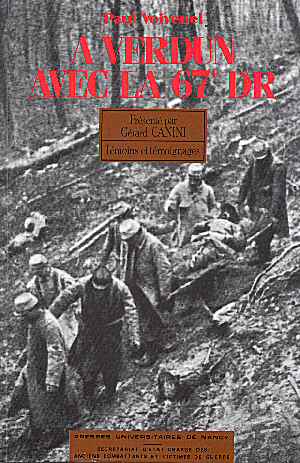 |
Paul Voivenel in cited by Jean Norton-Cru for 4 books, quite technical, that have been written by this doctor, based on his wartime observations ("Le Courage", "La Psychologie du Soldat", "Le Cafard", "La Guerre des Gaz") ("The Courage", "The Soldier's Psychology", "The Homesick", "The Gaz War"). It's only at the end of the thirties that he agreed to edit his personnal notes. "A Verdun avec la 67e D.R." ("In Verdun, with the 67th Reserve Division") is gathering extracts taht are related to Verdun, from February to September 1916. Accompagning the 211th Infantry Regiment in its ordeal, he tells the Meuse left bank fights in spring 1916, tnen later in Thiaumont and Vaux-Chapitre during summer, as they were experienced by a Division Ambulance Doctor, very close to the first lines and under the shelling. |
Soon some other French witnesses and novelists :
'Secteurs d'Enfer' (Clair)
'Aux Lueurs du Brasier 1917-1920' (Christophe)
'La Cote 304' (d'Arcangues)
'Au Pays des Fusées' (Delomme)
'De la Marne au Rhin' (Forain)
'La Nuit Casquée' (Guillot)
'Là-Bas avec Ceux qui Souffrent' (Hallé)
'De Secrètes Injustices' (Hanotte)
'Lieutenant Morin' (Morin)
'Journal d'un Simple Soldat' (Riou)
'Sous la Pluie de Fer' (Tardieu)
'Notes d'un Combattant de la Campagne 1914-1918' (Tasnier)
Belgian witnesses and novelists
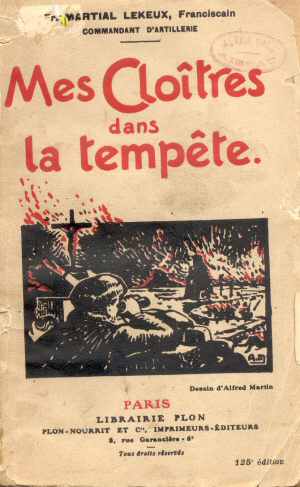 |
Another mystical book... this time written by a Belgian artillery man, Martial Lekeux, 3rd Field Artillery Regiment, became a monk after war. But only mystic only in some chapters : between them can be found 4 years of war, from Liege in 1914 to the Yser trenches, passing by Antwerp, described with a great realism in ‘Mes Cloîtres dans la Tempête’ ("My Cloisters in the Storm") - (1922). . |
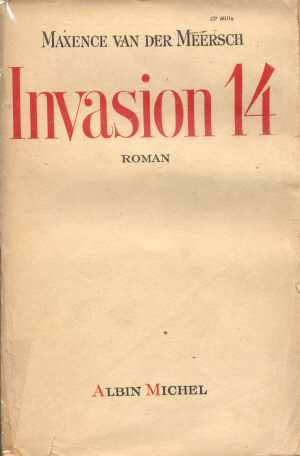 |
So many pages for this "Invasion 14" (1947)... quite a long novel illustrating the beginnings of the war in Belgium. Maxence Vandermeersch is a traditional Flemish author, his description of the deprivations of the occupied zones, which one often agrees to find more difficult than those of 1940-1945 is particularly interesting. |
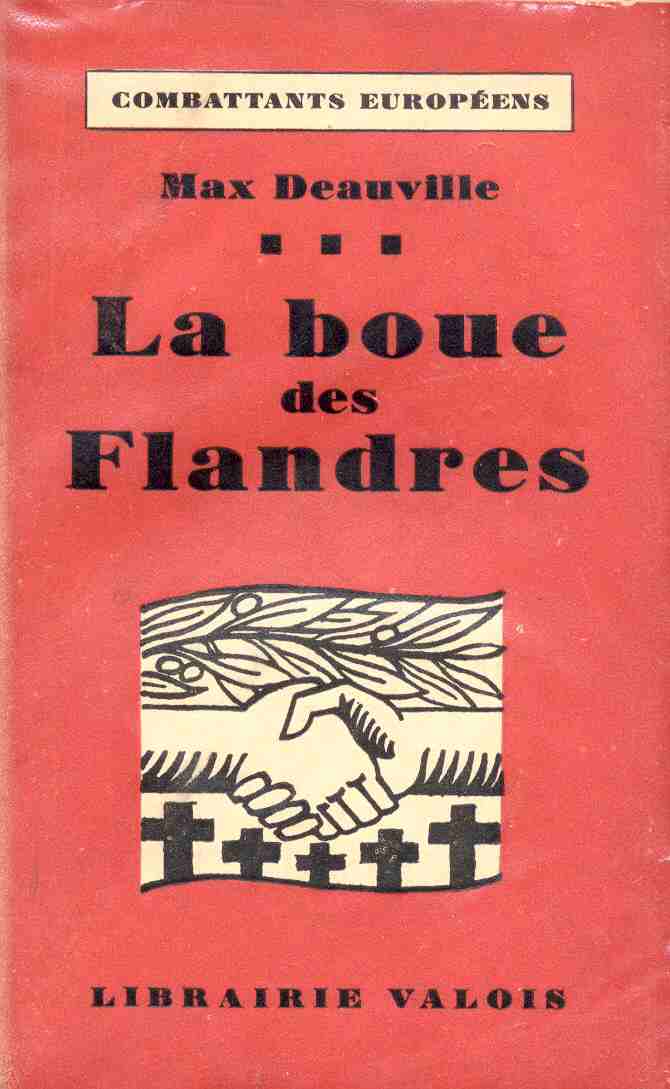 |
The so severe Norton Cru considers the Belgian Doctor Max Deauville (1st Regiment of Grenadiers) like one of the best witnessing doctors of the Great War. In a very simple and human style, the two volumes gathering his memories of the war, entitled ‘Jusqu’à l’Yser’ ("Until the Yser") - (1917) and ‘La Boue des Flandres’ ("The Flanders Mud") - (1922) tell the War of the little but heroic Belgian Army on the small portion of the front in the Flanders. |
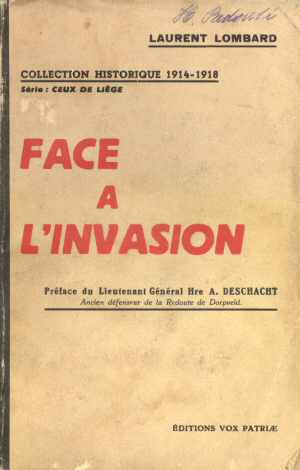 |
Laurent Lombard is a prolific Belgian author for this period. He wrote about ten works in the Thirties, reporting mainly the war in August 14 around Liege in Belgium. Among the most famous titles: ‘L’Epopée de Loncin’ ("Epic of Loncin"), ‘Sous les Ouragans d’Acier’ (“Under the Hurricanes of Steel"), ‘Ludendorff à Liège’ ("Ludendorf in Liege"), etc... Of course you will find these a bit ' belgo-triumphing ', but they offer the high interest to explore with quite small details this battle which slowed down the departure the German dash since the very first days. |
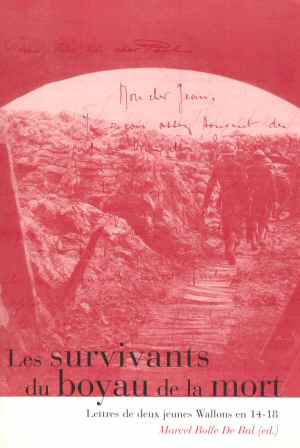 |
In may 1916, Paul Heuson, Walloon war volunteer, is badly wounded in the Boyau de la Mort (Dead's trench) near Dixmude. From his hospital bed, he is sharing a lot of letters with his best friend, Jean Bolle, who fought in this area until 1918. That correspondance is making the essence of Marcel Bolle de Bal's book, "Les Survivants du Boyau de la Mort" ("Death's Trench Survivors"). Moving friendship, rare witnesses of a terrible time when the Belgian territory was reduced to some tens of squar kilometers beaten by the heavy shelling ... |
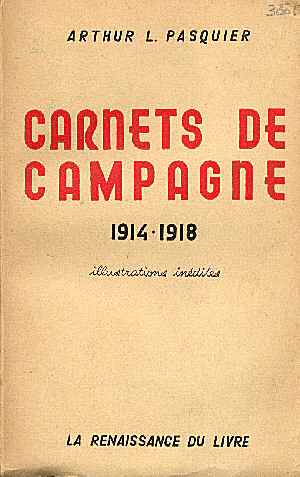 |
Published more than 20 years after the end of the war, those "Carnets de Campagne 1914-1918" ("Campaign Notes") are nevertheless remarkable : in July 1914 Arthur L. Pasquier succeeds with his engineering studies and receives a motorcycle from his parents. It's with this engine that he joins the 8th Infantry Regiment at the Belgian mobilization, and becomes liaison agent. Trapped in Brussels invaded by German troops, he escapes and joins his regiment agian ... using the tramway line to Gent ! Antwerp, Dixmuide, the Yser, the north of France... and the army motorcycles will be his world for 4 years time, crowned by the winners comeback in Brussels, and the Germany occupation. |
Soon some other Belgian witnesses and novelists :
'Les Ceinturonnés de la 88e' (André Hoornaert)
German witnesses and Novelists
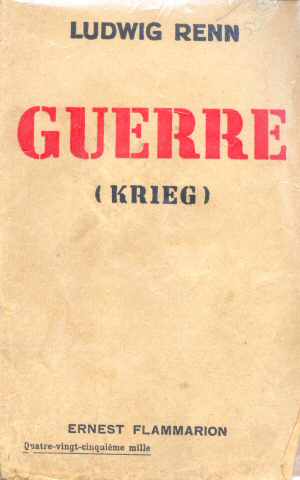 |
Here is one of the German books that I preferred. ‘Krieg’ ("War") - (1928), by Ludwig Renn starts with a rather disturbing tone. As with Ernst Jünger, the fights are initially described as epic and heroic events. The German troops cross Belgium that deserves the reprisals against a hostile and treacherous population, and that 'beautiful and legitimate war' continues in France. But imperceptibly, pages after pages, the hero slowly feels his certainties eroding, and gradually it is the horror, the fear, the anguish and the doubt that prevail. |
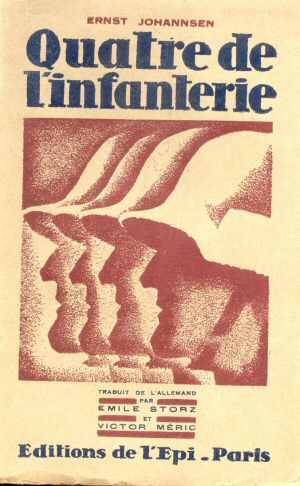 |
The west front in 1918, is for the exhausted German army the offensive of the last chance, which seemed well to succeed, then the dramatic generalized collapse, the discouragement, the rout. Without willing to present other ideas than the simple relation of these facts and this state of mind among a goup of four infantrymen, Ernst Johannsen carries out, with "Four Guys of the Infantry" (1928) a black novel, almost as desperate as "Nothing New on the Western Front". |
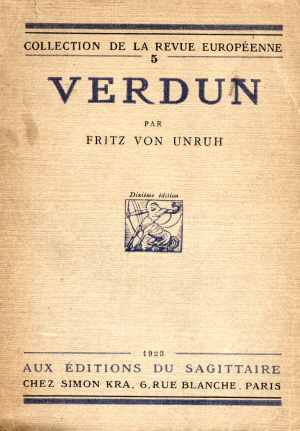 |
Cavalry Officer, Fritz von Unruh made with his "Verdun" (1923) a pacifist novel, describing on the German point of view the toughness of the fights in this sector. A little too fictionous, even leading means to deform the truth from time to time. Norton Cru even declared that one does not recognize the battle field of Verdun under this grimage... Too bad ! |
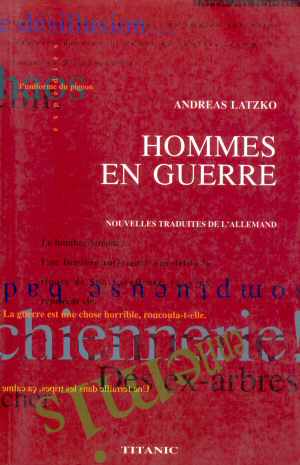 |
Officer in the Austro-Hungarian army, Andreas Latzko was wounded in 1915 on the Italian front. His description of the horrors of the war, written in "Men in War" in 1920, did not please the Nazi politicians who ordered the burning of this books and caused the exile of the author in the Netherlands. To read also because it is one of the rare witnesses coming from the old and sunked Vienna Empire. |
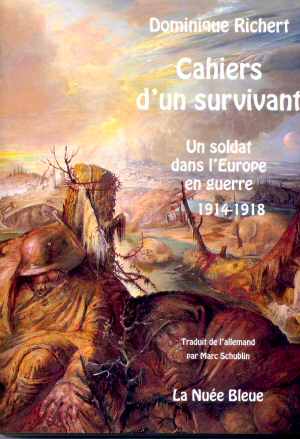 |
Young farmer living in Alsace, it is under the 'feldgrau' uniform and the spiked helmet that Dominique Richert is called up for the military service in 1913. He will live 4 years on the front, that will carry him in Flanders, France, Poland, Romania and Russia. He will desert in 1918. His memories, ‘Carnets d’un Survivant’ ("A Survivor’s Notebooks") were published only in 1987, following the discovery of its 300 report pages somewhere in the german federal archives. Richert described there his experience with a great preoccupation of precision. He his definitely a pacifist mind, but without revolt. Probably one of the most direct (then faithful) witnesses available on the German side for the french enrolled |
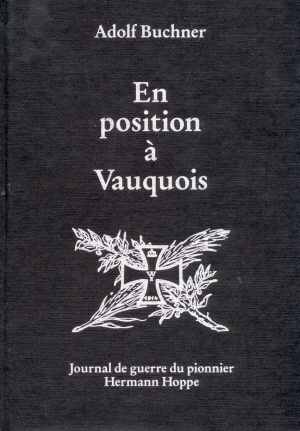 |
It is always passionating to read the account of the same battle by protagonists of the two different sides. This book by Adolf Buchner, includes in ‘En Position à Vauquois’ ("In position at Vauquois") the notes of the pioneer Hermann Hoppe. It must be read in parallel with ‘Nous Autres à Vauquois’ ("We at Vauquois") of Andre Pézard. These are here the point of view of those who transformed the Vauquois Hill into a bloody trap, and who fought sometimes under the ground. This work is decorated with many photographs and maps, and enriched very interesting historical notes. |
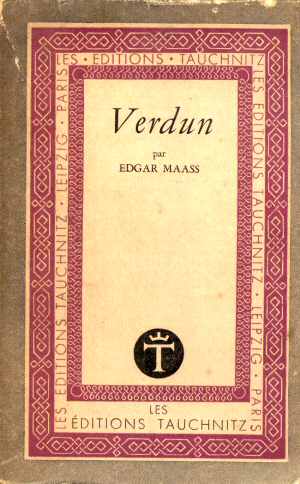 |
Here another German novel of the post-war period, doubtless directly inspired by the memories of the author Edgar Maas. If the descriptions of the war landscapes are rather good, the reading of "Verdun" (1942) is however a little disappointing. Just another story of comrades in war, that the manish life, the dangers and discomfort weld, and who suffer each time that one of them is wounded or killed. It could be a good theme if this was just a circonstance to dress an opinion of revolt, or even of militarism. It did not seem the case to me. Too bad ! |
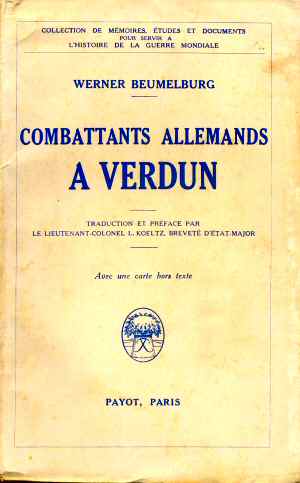 |
We will meet again Werner Beumelburg in the "History Books" section, where he is having a recognized role of German WW1 historian, but we must not neglect the good valor of that writer as a direct witness. That dark and bloody book, "Combattants Allemands à Verdun" ("German Fighters in Verdun"), was written on the base of his own soldier experience in the sector of the Fort of Douaumont (named 'The Coffin Cover' by the Kaiser troops), near Verdun, in 1916. It is a good work, without hate for the enemy, witnessing the friendship in doom, like so much other German books. |
Coming soon : other German witnesses
'Holocaust' (William Hermanns)
'Le Monde d'Hier' (Stephan Zweig)
'Education Héroïque devant Verdun' (Arnold Zweig)
Some English or American witnesses and novelists
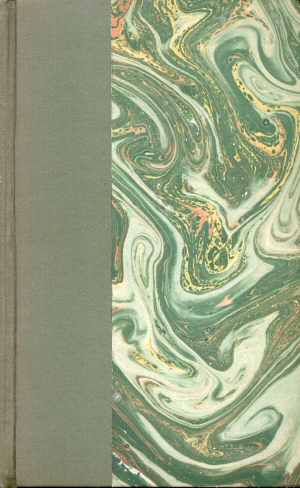 |
Poet and writer, Richard Aldington was 26 years old and left an editor job with the magazine "The Egoist" (periodic of the school of the Picturists poets) when he enrolled at the end of 1916. The experiment of the war traumatised him and he decided to describe it in a highly autobiographical novel, "Death of a Hero" (1929). The second volume is devoted at the departure of the "hero" for the French front (probably in Artois at the end of 1916). Men treated like herd by vociferating and haughty officers, the dull existence insulting warrant-officers, with sudden puffs of violence. It is a bitter indictment, revolted, quite near to Barbusse. |
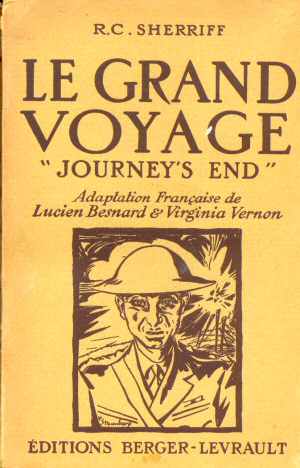 |
At the end of the war, RC Sherriff did not resume his studies in Oxford, which he stopped to participate to the conflict. He wrote a theater work, "Journey's End" (1930) which evoked his own experience rather accurately. Simple history proceeding in the single scene of a English officers dug-out on the Saint-Quentin front in March 1918, it is worth reading, especially for the psychological examination of its characters, and the description of the lifestyle of the officers. In spite of great initial difficulties to find an editor, the part ends up being an enormous world success, and its author became a celebrity. |
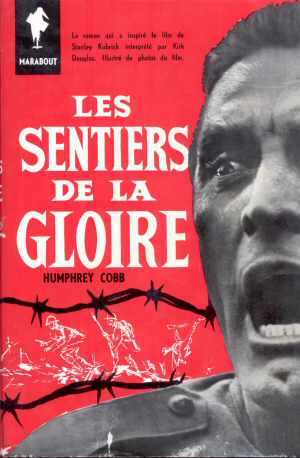 |
Stanley Kubrick made a film with this novel by Humphrey Cobb bearing the same name "The Paths of Glory" (1958 for the book), with Kirk Douglas in the principal role. This work deals with the injustices of the war courts who led so many soldiers to the firing squad. The action happens in the French Army in 1917, and shows an officer fighting against a dehumanized high command to save three of his men. The film caused many incidents in France. It is true that it strikes a blow at the honor of the headquarters of the winners of the war ... |
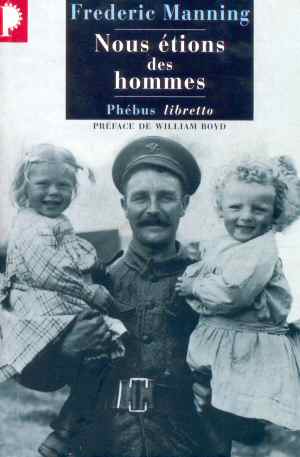 |
Sir T.E. Lawrence, William Boyd and Ernest Hemingway acclaimed "Her Privates We" as one of the english language books describing the more reastically the ambiance of the fighters life. Effectively, Frederic Manning, who used to be simple soldier in the ranks of HerMajesty Army, is relating without any disguise the life and death of an English soldier. Sometimes using of crude language (look at the title joke : 'Her Privates We' meaning either 'Her Majesty Soldiers' or 'Her Intimates Bodyparts'), often using of lassitude with sudden violent strikes, just as it was in trench life ! |
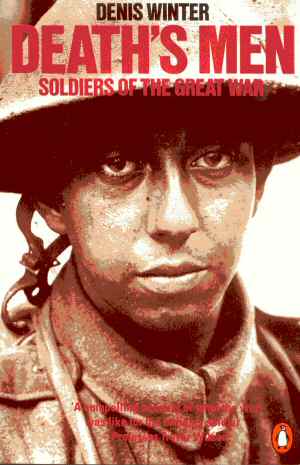 |
Denis Winter collected, in a very rich mostly english bibliography, witnesses of WW1 soldiers. They are widely illustrating his "Death's Men : Soldiers of the Great War" describing the life and death of the British simple soldiers, from enrolling to the end of the war, passing through the training, the trenches, the fights, the losses, the rest, etc... Quite a good way for french-speaking people to discover a wide variety of english-speaking witnesses. |
Coming soon some other british witnesses :
With a Machine Gun to Cambrai (George Coppard)